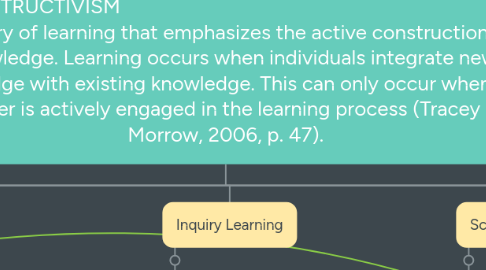
1. Characteristics:
1.1. 1. Learning can occur in the absence of observable indicators (Tracey & Morrow, 2006, p. 47)
1.2. 2. Learning results from a form of hypothesis testing (Tracey & Morrow, 2006, p. 47)
1.3. 3. The process of making inferences is central to the learning process (Tracey & Morrow, 2006, p. 47)
2. Inquiry Learning
2.1. John Dewey was an American constructivist. His philosophy of education became known as inquiry learning (Tracey & Morrow, 2006, p. 49).
2.1.1. Tracey & Morrow (2006) state, "Inquiry learning suggests that to optimize learning, students need to test hypotheses, draw conclusions, and reflect on the original problem and the thinking processes needed to solve it" (p. 49).
2.1.1.1. Emphasizes the active construction of knowledge by individuals and views learning as an internal, not necessarily observable (Tracey & Morrow, 2006, p. 50).
3. Schema Theory
3.1. This theory explains how knowledge is created and used by learners (Tracey & Morrow, 2006, p. 51).
3.1.1. Schemata is entirely based off of a person's background and what they have been through (Anderson, 1984) Everyone's schemas are INDIVIDUALIZED (Tracey & Morrow, 2006, p. 51).
3.1.1.1. The more elaborated your schema is on a certain topic, the more easily you will be able to learn new info---without existing schemas, learning is harder (Tracey & Morrow, 2006, p. 51).
3.1.1.1.1. 3 processes of schema theory through which knowledge changes-- accretion, tuning, restructuring (Tracey & Morrow, 2006, p. 52).
4. Transactional/Reader Response Theory
4.1. a further expansion of schema theory--derived from the idea that readers have individualized reading experiences because each reader has unique background schemas (Tracey & Morrow, 2006, p. 55).
4.1.1. 2 kinds of responses that readers have to texts: efferent (fact oriented) and aesthetic (personally and emotionally based) (Tracey & Morrow, 2006, p. 55).
4.1.1.1. Emphasizes the active role of the reader in meaning making and recognizes the centrality of internal, nonobservable events to learning and knowledge construction (Tracey & Morrow, 2006, p. 56).
4.1.1.1.1. The text guides reader to make their own meaning based off of their own experiences.
5. Psycholinguistic Theory/ Whole Language Theory
5.1. Reading is primarily a language process--readers rely on language cueing systems to help them rapidly read text (Tracey & Morrow, 2006, p. 57).
5.1.1. syntactic (grammar), semantic (meaning), and graphophonic information (visual pattern)
5.1.1.1. The more familiar a reader is with a topic, the less she needs to rely on the printed text (Tracey & Morrow, 2006, p. 58).
5.1.1.1.1. PREDICTION=KEY PART OF READING PROCESS reader makes and tests hypotheses as he/she reads
6. Metacognitive Theory
6.1. Metacognition is thinking about your own thinking. Readers are aware of their own comprehension. Readers apply fix-up strategies such as rereading and slowing down.
6.1.1. Struggling readers have less metacognitive awareness compared to proficient readers and younger readers have less than older readers.
6.1.1.1. During metacognitive instruction, teacher provides explicit instruction to teach ONE metacognitive strategy and how/when to use it. Must take place through "I do", "we do", "you do" (Tracey & Morrow, 2006, p. 63).
6.1.1.1.1. Through repetition, construction, development, and encouragement readers will come around and use the strategies
7. Engagement Theory
7.1. Use of metacognitive strategies to build understanding
7.1.1. Engaged readers are social. They talk to peers about what they read and learn.
7.1.1.1. Use of Concept-Oriented Reading Instruction (CORI) to engage students
7.1.1.1.1. 5 major components: themes, student choice, hands-on activities, genres, and social collaboration
8. Critical Literacy Perspective
8.1. Is NOT about cognitive processing IS about ways to see through texts, their description of cultures & worlds and how they try to position you (Luke & Freebody, 1997)
8.1.1. Respond to literature at a personal level (Luke & Freebody, 1997)
8.1.1.1. People's experiences have a direct impact on their ability to read and comprehend.
8.1.1.1.1. Teachings in reading are teachings of cultural ways of looking, describing, and explaining (Luke & Freebody, 1997)
9. References:
9.1. Anderson, R. C. (1984). Learning to read in American schools: Basal readers and content texts. Hillsdale, NJ: L. Erlbaum Associates.
9.1.1. Tracey, D.H., & Morrow L.M. (2006). Lenses on reading: An introduction to theories and models. New York: Guilford Press.
9.1.1.1. Luke, A., & Freebody, P. (1997). The social Practices of Reading. In S. Muspratt, A. Luke, & P. Freebody (Eds.), Constructing Critical Literacies: Teaching and Learning Textual Practice (pp. 185-226). Cresskill, NJ:Hampton Press.

